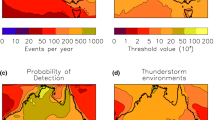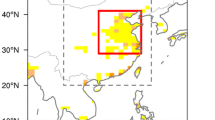Abstract
This study provides the first climatological synthesis of how urbanization augments warm-season convection among a range of cities in the southeastern U.S. By comparing the location of convection in these cities and adjacent control regions via high-resolution, radar reflectivity and lightning data, we illustrate that demographic and land-use changes feed back to local atmospheric processes that promote thunderstorm formation and persistence. Composite radar data for a 10-year, June–August period are stratified according to specific “medium” and “high” reflectivity thresholds. As surrogates for potentially strong (medium reflectivity) and severe (high reflectivity) thunderstorms, these radar climatologies can be used to determine if cities are inducing more intense events. Results demonstrate positive urban amplification of thunderstorm frequency and intensity for major cities. Mid-sized cities investigated had more subtle urban effects, suggesting that the urban influences on thunderstorm development and strength are muted by land cover and climatological controls. By examining cities of various sizes, as well as rural counterparts, the investigation determined that the degree of urban thunderstorm augmentation corresponds to the geometry of the urban footprint. The research provides a methodological template for continued monitoring of anthropogenically forced and/or modified thunderstorms.




Similar content being viewed by others
References
Bentley ML, Stallins JA (2005) Climatology of cloud-to-ground lightning in Georgia, USA, 1992–2003. Int J Climatol 25:1979–1996
Bentley ML, Ashley WS, Stallins JA (2010) Climatological radar delineation of urban convection for Atlanta, Georgia. Int J Climatol. doi:10.1002/joc.2021
Borden KA, Schmidtlein MC, Emrich CT, Piegorsch WW, Cutter SL (2007) Vulnerability of U.S. cities to environmental hazards. J Homel Security 4:2, Article 5 doi:10.2202/1547-7355.1279.
Brown ME, Arnold DL (1998) Land-surface-atmosphere interactions associated with deep convection in Illinois. Int J Climatol 18:1637–1653
Brown ME, McCann B (2004) Relating clustered convective events to land-surface features in Mississippi. Electron J Operat Meteorol 2004-EJ2 http://www.nwas.org/ej/pdf/2004-EJ2.pdf.
Burian S, Shepherd M (2005) Effect of urbanization on the diurnal rainfall pattern in Houston. Hydrolog Process 19:1089–1103
Carleton AM, Travis DJ, Adegoke JO, Arnold DL, Curran S (2008) Synoptic circulation and land surface influences on convection in the Midwest U.S. “Corn Belt” during the summers of 1999 and 2000. Part II: Role of vegetation boundaries. J Climate 21:3617–3641
Changnon SA (1988) Climatography of thunder events in the conterminous United States. Part II: Spatial aspects. J Climate 1:399–405
Changnon SA, Semonin RG, Auer AH, Braham RR, Hales J (1981) METROMEX: a review and summary. Meteorol Monogr 40, American Meteorological Society, Boston.
Changnon SA, Shealy RT, Scott RW (1991) Precipitation changes in fall, winter, and spring caused by St. Louis. J Appl Meteorol 30:126–134
Chase TN, Pielke RA, Kittel TG, Nemani RR, Running SW (2000) Simulated impacts of historical land cover changes on global climate in northern winter. Clim Dynam 16:93–105
Court A, Griffiths JF (1981) Thunderstorm climatology. In: Kessler (ed) Thunderstorm morphology and dynamics. Univ. of Oklahoma Press, Norman, pp 9–39.
Crum TD, Alberty RL (1993) The WSR-88D and the WSR-88D operational support facility. Bull Am Meteorol Soc 74:1669–1687
Cummins KL, Murphy MJ, Bardo EA, Hiscox WL, Pyle RB, Pifer AE (1998) A combined TOA/MDF technology upgrade of the U.S. National Lightning Detection Network. J Geophys Res 103:9035–9044
Climate Change Science Program and Subcommittee on Global Change Research (CCSP) (2003) Strategic Plan for the Climate Change Science Program. A report by the Climate Change Science Program and the Subcommittee on Global Change Research, pp. 202 http://www.climatescience.gov/Library/stratplan2003/final/ccspstratplan2003-all.pdf.
Dabberdt WF, Crook A, Mueller C, Hales J, Zubrick S, Krajewski W, Doran JC, King C, Keener RN, Bornstein R, Rodenhuis D, Kocin P, Rossetti MA, Sharrocks F, Stanley Sr. EM (2000) Forecast issues in the urban zone: report of the 10th prospectus development team of the U.S. Weather Research Program. Bull Am Meteorol Soc 81:2047–2064
Dilley M, Chen RS, Deichman U, Lerner-Lam AL, Arnold M (2005) Natural disaster hotspots: a global risk analysis. World Bank, Washington D.C.
Dixon PG, Mote TL (2003) Patterns and causes of Atlanta’s urban heat island-initiated precipitation. J Appl Meteorol 42:1273–1284
Falconer PD (1984) A radar-based climatology of thunderstorm days across New York state. J Clim Appl Meteorol 23:1115–1120
Fall S, Niyogi D, Gluhovsky A, Pielke RA, Kalnay E, Rochon G (2009) Impacts of land use land cover on temperature trends over the continental United States: assessment using the North American Regional Reanalysis. Int J Climatol. doi:10.1002/joc.1996
Feddema JJ, Oleson KW, Bonan GB, Mearns LO, Buja LE, Meehl GA, Washington WM (2005) The importance of land-cover change in simulating future climates. Science 310:1674–1678
Gamache JF, Houze RA (1982) Mesoscale air motions associated with a tropical squall line. Mon Weather Rev 110:118–135
Gibson HM, Vonder Haar TH (1990) Cloud and convection frequencies over the southeast United States as related to small-scale geographic features. Mon Weather Rev 118:2215–2227
Hale RC, Gallo KP, Loveland TR (2008) Influences of specific land use/land cover conversions on climatological normals of near-surface temperature. J Geophys Res. doi:10.1029/2007JD009548
Hand L, Shepherd JM (2009) An investigation of warm season spatial rainfall variability in Oklahoma City: possible linkages to urbanization and prevailing wind. J Appl Meteorol Climatol 48:251–269
Huff FA, Changnon SA (1973) Precipitation modification by major urban areas. Bull Am Meteorol Soc 54:1220–1232
Kalnay E, Cai M (2003) Impact of urbanization and land-use change on climate. Nature 423:528–531
Kaufmann RK, Seto KC, Schneider A, Liu Z, Zhou L, Wang W (2007) Climate response to rapid urban growth: evidence of a human-induced precipitation deficit. J Climate 20:2299–2306
Kishtawal CM, Niyogi D, Tewari M, Pielke RA, Shepherd JM (2010) Urbanization signature in the observed heavy rainfall climatology over India. Int J Climatol. doi:10.1002/joc.2044
Lo CP, Yang X (2002) Drivers of land-use/land-cover changes and dynamic modeling for the Atlanta, Georgia Metropolitan Area. Photogramm Eng Rem Sens 68:1062–1073
Lowry W (1998) Urban effects on precipitation amount. Progr Phys Geogr 21:477–520
Mahmood R, Foster SA, Keeling T, Hubbard KG, Carlson C, Leeper R (2006) Impacts of irrigation on 20th Century temperatures in the Northern Great Plains. Global Planet Change 54:1–18
Mahmood R, Quintanar AI, Conner G, Leeper R, Dobler S, Pielke Sr. RA, Beltran-Przekurat A, Hubbard KG, Niyogi D, Bonan G, Lawrence P, Chase T, McNider R, Wu Y, McAlpine C, Deo R, Etter A, Gameda S, Qian B, Carleton A, Adegoke JO, Vezhapparambu S, Asefi S, Nair US, Sertel E, Legates DR, Hale R, Frauenfeld OW, Watts A, Shepherd M, Mitra C, Anantharaj VG, Fall S, Chang H-I, Lund R, Treviño A, Blanken P, Du J, Syktus J (2010) Impacts of land use/land cover change on climate and future research priorities. Bull Amer Meteorol Soc 91:37–46
Mote TL, Lacke MC, Shepherd JM (2007) Radar signatures of the urban effect on precipitation distribution: a case study for Atlanta, Georgia. Geophys Res Lett 34:L20710
NRC (2005) Radiative forcing of climate change: expanding the concept and addressing uncertainties. National Research Council, pp. 208 http://www.nap.edu/catalog.php?record_id=11175.
NRC (2010) When weather matters: science and service to meet critical societal needs. National Research Council, pp. 208 http://www.nap.edu/catalog.php?record_id=12888.
Oke TR (1981) Canyon geometry and nocturnal urban heat island: comparison of scale model and field observations. Int J Climatol 1:237–254
Oke TR (1982) The energetic basis of the urban heat island. Q J Roy Meteorol Soc 108:1–24
Orville RE, Huffines G, Nielsen-Gammon J, Zhang RY, Ely B, Steiger S, Phillips S, Allen S, Read W (2001) Enhancement of cloud-to-ground lightning over Houston, Texas. Geophys Res Lett 28:2597–2600
Parker MD, Knievel JC (2005) Do meteorologists suppress thunderstorms? Radar-derived statistics and the behavior of moist convection. Bull Am Meteorol Soc 86:341–358
Price C, Rind D (1994) Possible implications of global climate change on global lightning distributions and frequencies. J Geophys Res 99:10823–10831
Rickenbach TM, Rutledge SA (1998) Convection in TOGA COARE: horizontal scale, morphology, and rainfall production. J Atmos Sci 55:2715–2729
Rudlosky SD, Fuelberg HE (2010) Pre- and post-upgrade distributions of NLDN reported cloud-to-ground lightning characteristics in the contiguous United states. Mon Weather Rev 138:3623–3633
Segal M, Arritt RW (1992) Non-classical mesoscale circulations caused by surface sensible heat flux gradients. Bull Am Meteorol Soc 73:1593–1604
Segal M, Leuthold M, Arritt RW, Anderson C, Shen J (1997) Small lake daytime breezes: some observational and conceptual evaluations. Bull Am Meteorol Soc 78:1135–1147
Shepherd JM (2005) A review of current investigations of urban-induced rainfall and recommendations for the future. Earth Interact 9:1–27
Shepherd JM, Pierce H, Negri AJ (2002) Rainfall modification by major urban areas: observations from spaceborne rain radar on the TRMM Satellite. J Appl Meteorol 41:689–701
Shepherd JM, Stallins JA, Jin M, Mote TL (2010) Urbanization: impacts on clouds, precipitation, and lightning. Monograph on Urban Ecological Ecosystems. Eds. Jacqueline Peterson and Astrid Volder. American Society of Agronomy-Crop Science Society of America- Soil Science Society of America, pp. 354.
Shepherd JM, Mote TL, Dowd J, Roden M, Knox P, McCutcheon SC, Nelson SE (2011) An overview of synoptic and mesoscale factors contributing to the disastrous Atlanta Flood of 2009. Bull Amer Meteorol Soc 92:861–870
Sheridan SC (2002) Redevelopment of a weather-type classification scheme for North America. Int J Climatol 22:51–68
Smith JR, Fuelberg HE, Watson AI (2005) Warm season lightning distributions over the northern Gulf of Mexico coast and their relation to synoptic-scale and mesoscale environments. Weather Forecast 20:415–438
Stallins JA, Bentley ML (2006) A descriptive GIS-based assessment of urban cloud-to-ground flash distribution for Atlanta, Georgia. Appl Geogr 26:242–259
Stallins JA, Rose S (2008) Urban lightning: current research, methods, and the geographical perspective. Geography Compass. doi:10.1111/j.17498198.2008.00110.x
Trapp RJ, Diffenbaugh NS, Gluhovsky A (2009) Transient response of severe thunderstorm forcing to elevated greenhouse gas concentrations. Geophys Res Lett 36:L017030. doi:10.1029/2008GL036203
Trenberth KE, Jones PD, Ambenje P, Bojariu R, Easterling D, Klein TA, Parker D, Rahimzadeh F, Renwick JA, Rusticucci M, Soden B, Zhai P (2007) Observations: surface and atmospheric climate change. In: Solomon S, Qin D, Manning M, Chen Z, Marquis M, Averyt KB, Tignor M, Miller HL (eds) Climate Change 2007: The Physical Science Basis Contribution of working group I to the fourth assessment report of the Intergovernmental Panel on Climate Change. Cambridge University Press, Cambridge
UNFPA (2007) State of the world population: unleashing the potential of urban growth United Nations population fund http://www.unfpa.org/swp/2007/.
United Nations (2007) Population prospects: The 2006 Revision and World Urbanization Prospects: The 2007 Revision. Population Division of the Department of Economic and Social Affairs of the United Nations Secretariat. http://esa.un.org/unup.
U.S. Geological Survey (2001a) National land cover data set 2001. Reston, Virginia. http://seamless.usgs.gov/products/nlcd01.php.
U.S. Geological Survey (2001b) Urban areas of the United States. Reston, Virginia. http://nationalatlas.gov/atlasftp.htmlr.
van den Heever SC, Cotton WR (2007) Urban aerosol impacts on downwind convective storms. J Appl Meteorol Climatol 46:828–850
Wacker RS, Orville RE (1999) Changes in measured lightning flash count and return stroke peak current after the 1994 US National Lightning Detection Network upgrade—1. Observations. J Geophys Res Atmos 104:2151–2157
Westcott NE (1995) Summertime cloud-to-ground lightning activity around major Midwestern urban areas. J Appl Meteorol 34:1633–1642
Acknowledgements
The authors wish to thank Phil Young and Rick Schwantes of the NIU Advanced Geospatial Laboratory for their technical expertise and equipment. Portions of this research were supported by National Science Foundation Grant #0649343.
Author information
Authors and Affiliations
Corresponding author
Rights and permissions
About this article
Cite this article
Ashley, W.S., Bentley, M.L. & Stallins, J.A. Urban-induced thunderstorm modification in the Southeast United States. Climatic Change 113, 481–498 (2012). https://doi.org/10.1007/s10584-011-0324-1
Received:
Accepted:
Published:
Issue Date:
DOI: https://doi.org/10.1007/s10584-011-0324-1




